Planning and Implementation of Health Promotion for Diabetes Patients
VerifiedAdded on 2023/06/09
|6
|1402
|118
Essay
AI Summary
This report provides a comprehensive analysis of the systematic planning and implementation of diabetes health programs. It explores the importance of structured planning to manage uncertainties and achieve program goals. The essay delves into the use of models like PRECEDE-PROCEED and Donabedian, highlighting their role in improving patient outcomes and ensuring quality healthcare. It also discusses the significance of stakeholder involvement, including primary and secondary stakeholders, in funding, commissioning, and resource provision. Furthermore, the report emphasizes the value of effective communication and teamwork within these programs. The discussion includes various health programs and organizations in the United Kingdom, such as the NHS DPP, and concludes by underscoring the importance of these planning models in enhancing the success and promotion of diabetes health initiatives.
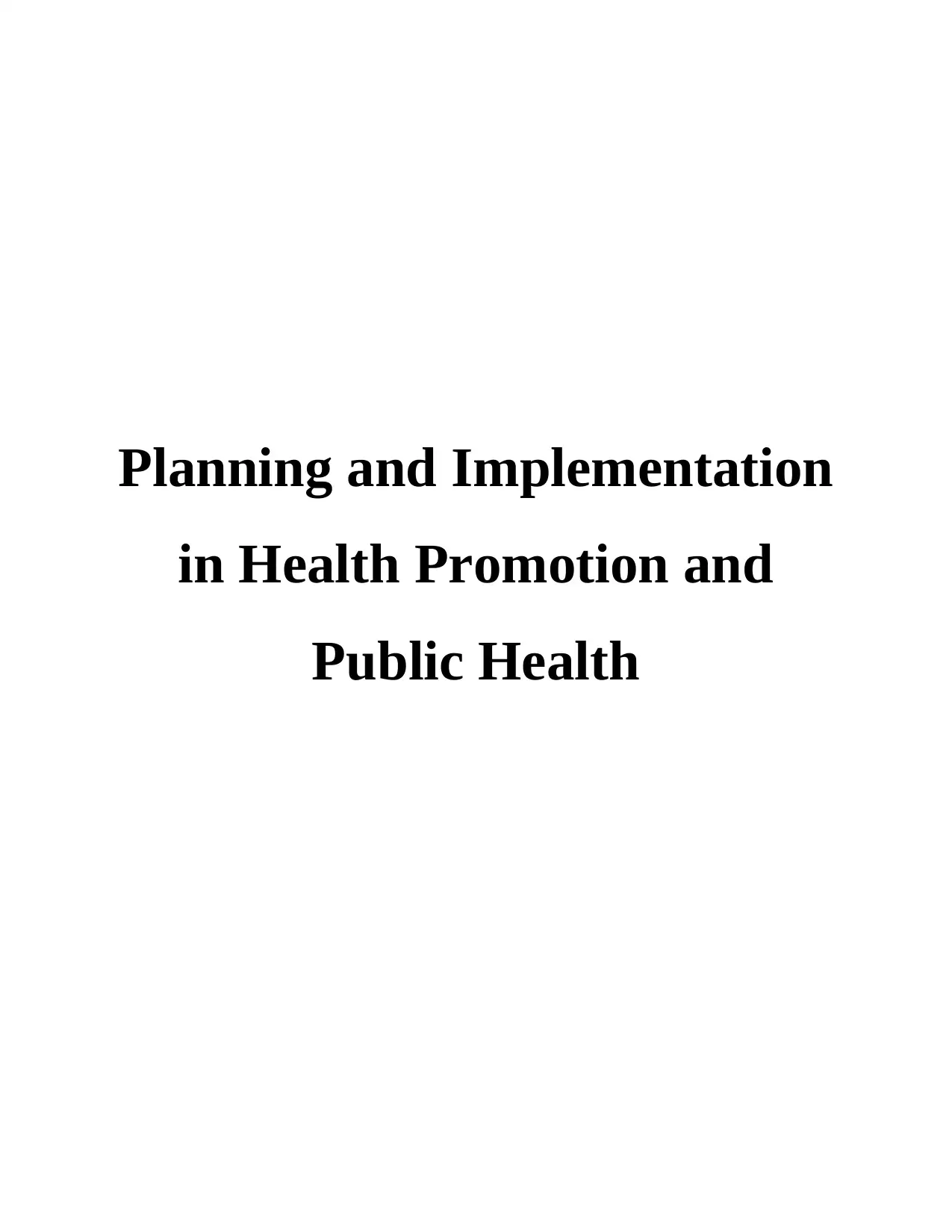
Planning and Implementation
in Health Promotion and
Public Health
in Health Promotion and
Public Health
Paraphrase This Document
Need a fresh take? Get an instant paraphrase of this document with our AI Paraphraser
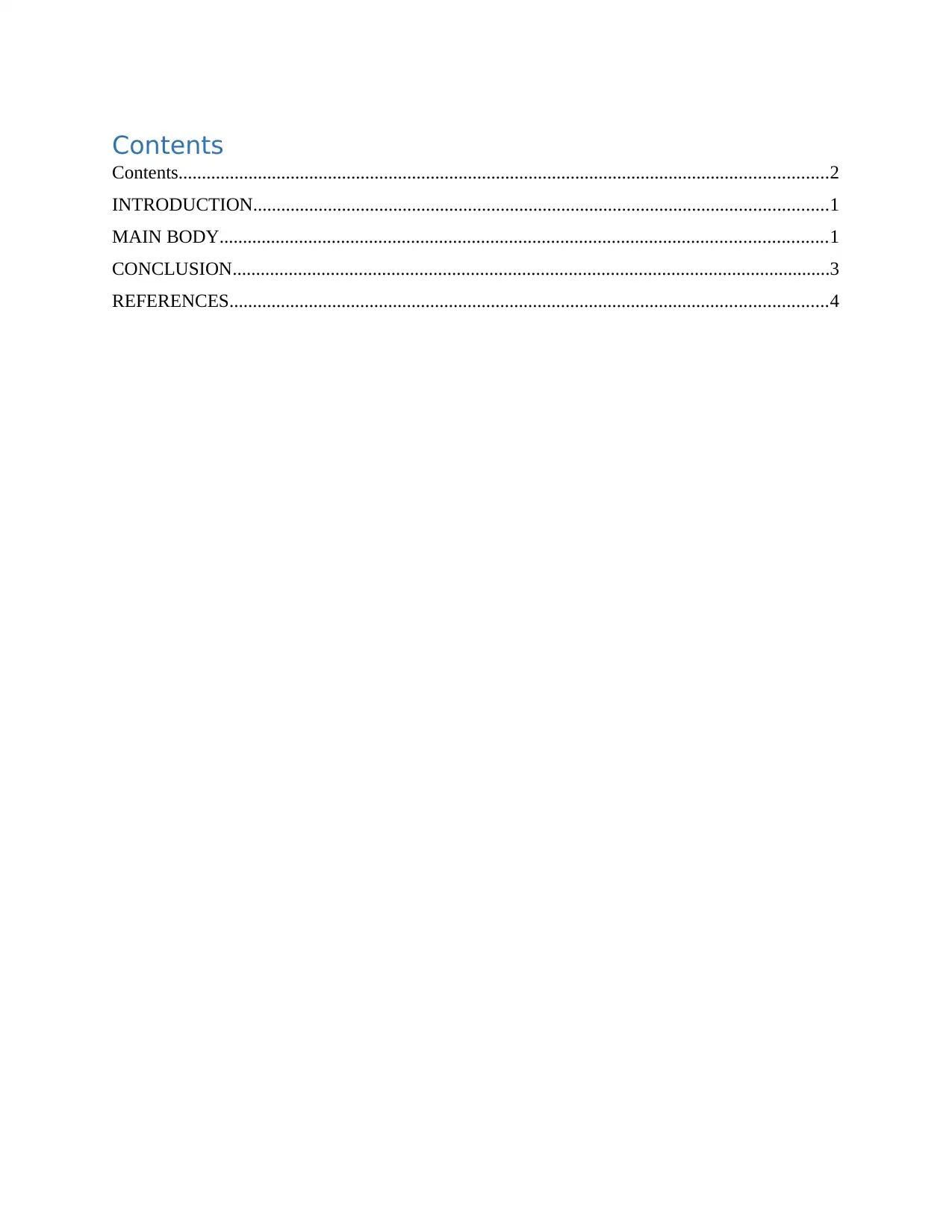
Contents
Contents...........................................................................................................................................2
INTRODUCTION...........................................................................................................................1
MAIN BODY..................................................................................................................................1
CONCLUSION................................................................................................................................3
REFERENCES................................................................................................................................4
Contents...........................................................................................................................................2
INTRODUCTION...........................................................................................................................1
MAIN BODY..................................................................................................................................1
CONCLUSION................................................................................................................................3
REFERENCES................................................................................................................................4
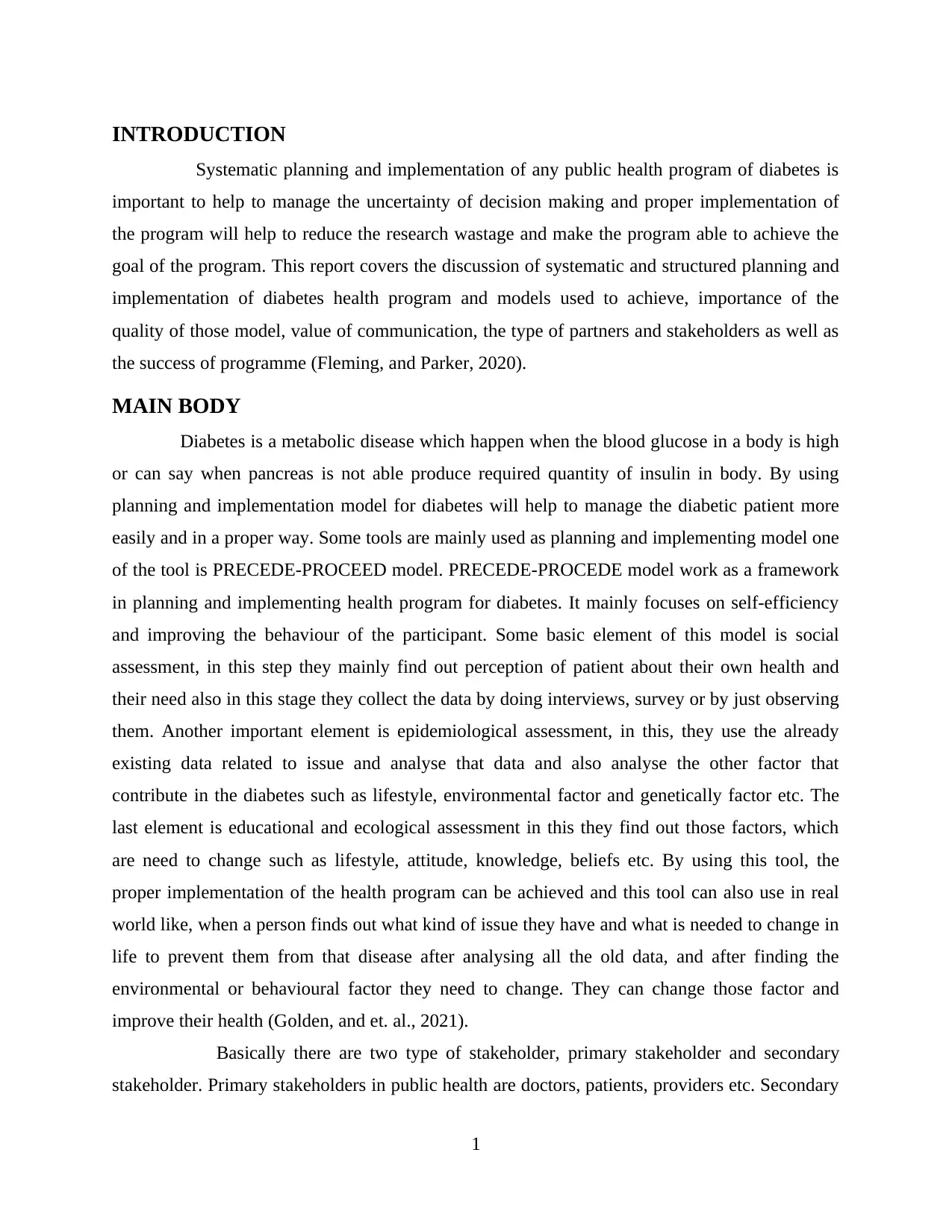
INTRODUCTION
Systematic planning and implementation of any public health program of diabetes is
important to help to manage the uncertainty of decision making and proper implementation of
the program will help to reduce the research wastage and make the program able to achieve the
goal of the program. This report covers the discussion of systematic and structured planning and
implementation of diabetes health program and models used to achieve, importance of the
quality of those model, value of communication, the type of partners and stakeholders as well as
the success of programme (Fleming, and Parker, 2020).
MAIN BODY
Diabetes is a metabolic disease which happen when the blood glucose in a body is high
or can say when pancreas is not able produce required quantity of insulin in body. By using
planning and implementation model for diabetes will help to manage the diabetic patient more
easily and in a proper way. Some tools are mainly used as planning and implementing model one
of the tool is PRECEDE-PROCEED model. PRECEDE-PROCEDE model work as a framework
in planning and implementing health program for diabetes. It mainly focuses on self-efficiency
and improving the behaviour of the participant. Some basic element of this model is social
assessment, in this step they mainly find out perception of patient about their own health and
their need also in this stage they collect the data by doing interviews, survey or by just observing
them. Another important element is epidemiological assessment, in this, they use the already
existing data related to issue and analyse that data and also analyse the other factor that
contribute in the diabetes such as lifestyle, environmental factor and genetically factor etc. The
last element is educational and ecological assessment in this they find out those factors, which
are need to change such as lifestyle, attitude, knowledge, beliefs etc. By using this tool, the
proper implementation of the health program can be achieved and this tool can also use in real
world like, when a person finds out what kind of issue they have and what is needed to change in
life to prevent them from that disease after analysing all the old data, and after finding the
environmental or behavioural factor they need to change. They can change those factor and
improve their health (Golden, and et. al., 2021).
Basically there are two type of stakeholder, primary stakeholder and secondary
stakeholder. Primary stakeholders in public health are doctors, patients, providers etc. Secondary
1
Systematic planning and implementation of any public health program of diabetes is
important to help to manage the uncertainty of decision making and proper implementation of
the program will help to reduce the research wastage and make the program able to achieve the
goal of the program. This report covers the discussion of systematic and structured planning and
implementation of diabetes health program and models used to achieve, importance of the
quality of those model, value of communication, the type of partners and stakeholders as well as
the success of programme (Fleming, and Parker, 2020).
MAIN BODY
Diabetes is a metabolic disease which happen when the blood glucose in a body is high
or can say when pancreas is not able produce required quantity of insulin in body. By using
planning and implementation model for diabetes will help to manage the diabetic patient more
easily and in a proper way. Some tools are mainly used as planning and implementing model one
of the tool is PRECEDE-PROCEED model. PRECEDE-PROCEDE model work as a framework
in planning and implementing health program for diabetes. It mainly focuses on self-efficiency
and improving the behaviour of the participant. Some basic element of this model is social
assessment, in this step they mainly find out perception of patient about their own health and
their need also in this stage they collect the data by doing interviews, survey or by just observing
them. Another important element is epidemiological assessment, in this, they use the already
existing data related to issue and analyse that data and also analyse the other factor that
contribute in the diabetes such as lifestyle, environmental factor and genetically factor etc. The
last element is educational and ecological assessment in this they find out those factors, which
are need to change such as lifestyle, attitude, knowledge, beliefs etc. By using this tool, the
proper implementation of the health program can be achieved and this tool can also use in real
world like, when a person finds out what kind of issue they have and what is needed to change in
life to prevent them from that disease after analysing all the old data, and after finding the
environmental or behavioural factor they need to change. They can change those factor and
improve their health (Golden, and et. al., 2021).
Basically there are two type of stakeholder, primary stakeholder and secondary
stakeholder. Primary stakeholders in public health are doctors, patients, providers etc. Secondary
1
⊘ This is a preview!⊘
Do you want full access?
Subscribe today to unlock all pages.

Trusted by 1+ million students worldwide
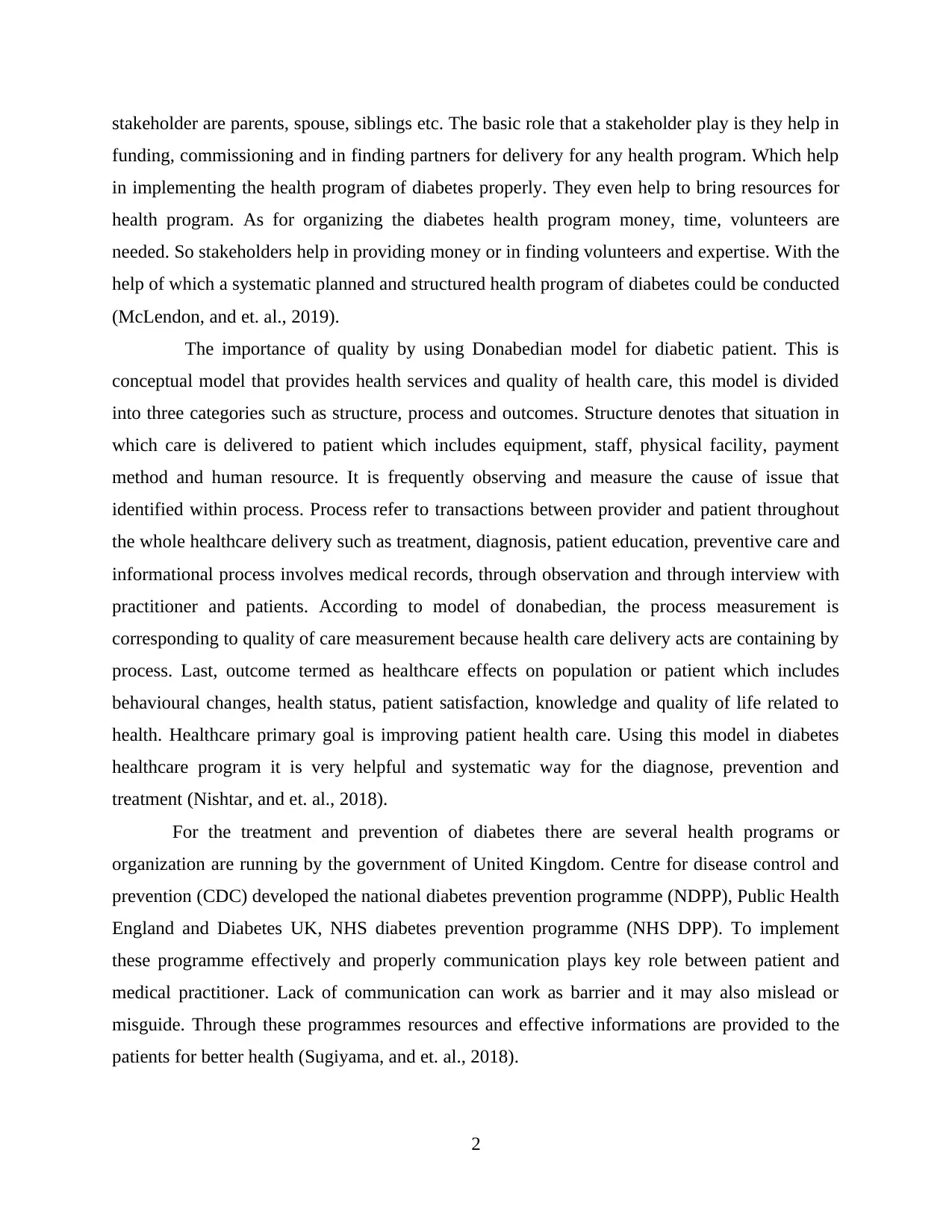
stakeholder are parents, spouse, siblings etc. The basic role that a stakeholder play is they help in
funding, commissioning and in finding partners for delivery for any health program. Which help
in implementing the health program of diabetes properly. They even help to bring resources for
health program. As for organizing the diabetes health program money, time, volunteers are
needed. So stakeholders help in providing money or in finding volunteers and expertise. With the
help of which a systematic planned and structured health program of diabetes could be conducted
(McLendon, and et. al., 2019).
The importance of quality by using Donabedian model for diabetic patient. This is
conceptual model that provides health services and quality of health care, this model is divided
into three categories such as structure, process and outcomes. Structure denotes that situation in
which care is delivered to patient which includes equipment, staff, physical facility, payment
method and human resource. It is frequently observing and measure the cause of issue that
identified within process. Process refer to transactions between provider and patient throughout
the whole healthcare delivery such as treatment, diagnosis, patient education, preventive care and
informational process involves medical records, through observation and through interview with
practitioner and patients. According to model of donabedian, the process measurement is
corresponding to quality of care measurement because health care delivery acts are containing by
process. Last, outcome termed as healthcare effects on population or patient which includes
behavioural changes, health status, patient satisfaction, knowledge and quality of life related to
health. Healthcare primary goal is improving patient health care. Using this model in diabetes
healthcare program it is very helpful and systematic way for the diagnose, prevention and
treatment (Nishtar, and et. al., 2018).
For the treatment and prevention of diabetes there are several health programs or
organization are running by the government of United Kingdom. Centre for disease control and
prevention (CDC) developed the national diabetes prevention programme (NDPP), Public Health
England and Diabetes UK, NHS diabetes prevention programme (NHS DPP). To implement
these programme effectively and properly communication plays key role between patient and
medical practitioner. Lack of communication can work as barrier and it may also mislead or
misguide. Through these programmes resources and effective informations are provided to the
patients for better health (Sugiyama, and et. al., 2018).
2
funding, commissioning and in finding partners for delivery for any health program. Which help
in implementing the health program of diabetes properly. They even help to bring resources for
health program. As for organizing the diabetes health program money, time, volunteers are
needed. So stakeholders help in providing money or in finding volunteers and expertise. With the
help of which a systematic planned and structured health program of diabetes could be conducted
(McLendon, and et. al., 2019).
The importance of quality by using Donabedian model for diabetic patient. This is
conceptual model that provides health services and quality of health care, this model is divided
into three categories such as structure, process and outcomes. Structure denotes that situation in
which care is delivered to patient which includes equipment, staff, physical facility, payment
method and human resource. It is frequently observing and measure the cause of issue that
identified within process. Process refer to transactions between provider and patient throughout
the whole healthcare delivery such as treatment, diagnosis, patient education, preventive care and
informational process involves medical records, through observation and through interview with
practitioner and patients. According to model of donabedian, the process measurement is
corresponding to quality of care measurement because health care delivery acts are containing by
process. Last, outcome termed as healthcare effects on population or patient which includes
behavioural changes, health status, patient satisfaction, knowledge and quality of life related to
health. Healthcare primary goal is improving patient health care. Using this model in diabetes
healthcare program it is very helpful and systematic way for the diagnose, prevention and
treatment (Nishtar, and et. al., 2018).
For the treatment and prevention of diabetes there are several health programs or
organization are running by the government of United Kingdom. Centre for disease control and
prevention (CDC) developed the national diabetes prevention programme (NDPP), Public Health
England and Diabetes UK, NHS diabetes prevention programme (NHS DPP). To implement
these programme effectively and properly communication plays key role between patient and
medical practitioner. Lack of communication can work as barrier and it may also mislead or
misguide. Through these programmes resources and effective informations are provided to the
patients for better health (Sugiyama, and et. al., 2018).
2
Paraphrase This Document
Need a fresh take? Get an instant paraphrase of this document with our AI Paraphraser
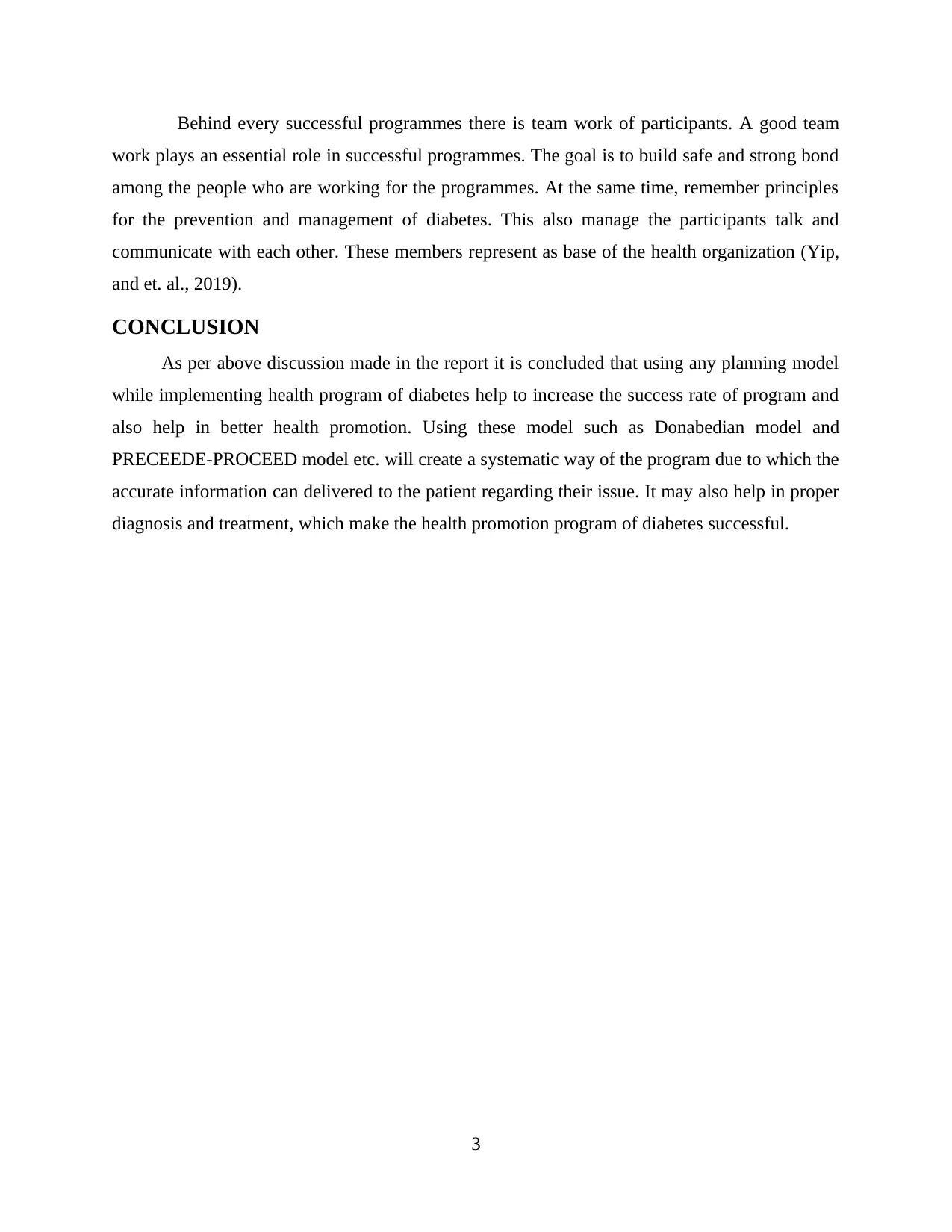
Behind every successful programmes there is team work of participants. A good team
work plays an essential role in successful programmes. The goal is to build safe and strong bond
among the people who are working for the programmes. At the same time, remember principles
for the prevention and management of diabetes. This also manage the participants talk and
communicate with each other. These members represent as base of the health organization (Yip,
and et. al., 2019).
CONCLUSION
As per above discussion made in the report it is concluded that using any planning model
while implementing health program of diabetes help to increase the success rate of program and
also help in better health promotion. Using these model such as Donabedian model and
PRECEEDE-PROCEED model etc. will create a systematic way of the program due to which the
accurate information can delivered to the patient regarding their issue. It may also help in proper
diagnosis and treatment, which make the health promotion program of diabetes successful.
3
work plays an essential role in successful programmes. The goal is to build safe and strong bond
among the people who are working for the programmes. At the same time, remember principles
for the prevention and management of diabetes. This also manage the participants talk and
communicate with each other. These members represent as base of the health organization (Yip,
and et. al., 2019).
CONCLUSION
As per above discussion made in the report it is concluded that using any planning model
while implementing health program of diabetes help to increase the success rate of program and
also help in better health promotion. Using these model such as Donabedian model and
PRECEEDE-PROCEED model etc. will create a systematic way of the program due to which the
accurate information can delivered to the patient regarding their issue. It may also help in proper
diagnosis and treatment, which make the health promotion program of diabetes successful.
3
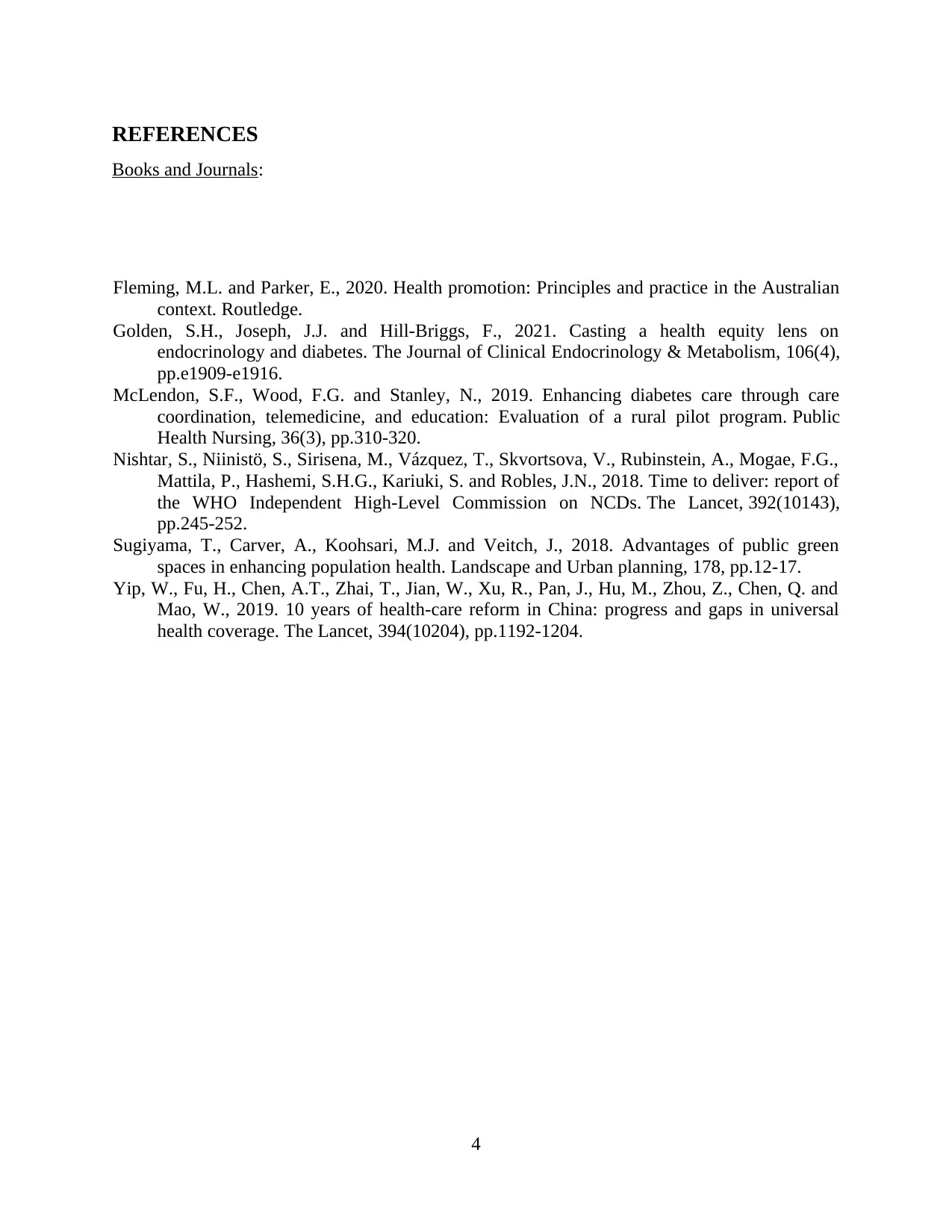
REFERENCES
Books and Journals:
Fleming, M.L. and Parker, E., 2020. Health promotion: Principles and practice in the Australian
context. Routledge.
Golden, S.H., Joseph, J.J. and Hill-Briggs, F., 2021. Casting a health equity lens on
endocrinology and diabetes. The Journal of Clinical Endocrinology & Metabolism, 106(4),
pp.e1909-e1916.
McLendon, S.F., Wood, F.G. and Stanley, N., 2019. Enhancing diabetes care through care
coordination, telemedicine, and education: Evaluation of a rural pilot program. Public
Health Nursing, 36(3), pp.310-320.
Nishtar, S., Niinistö, S., Sirisena, M., Vázquez, T., Skvortsova, V., Rubinstein, A., Mogae, F.G.,
Mattila, P., Hashemi, S.H.G., Kariuki, S. and Robles, J.N., 2018. Time to deliver: report of
the WHO Independent High-Level Commission on NCDs. The Lancet, 392(10143),
pp.245-252.
Sugiyama, T., Carver, A., Koohsari, M.J. and Veitch, J., 2018. Advantages of public green
spaces in enhancing population health. Landscape and Urban planning, 178, pp.12-17.
Yip, W., Fu, H., Chen, A.T., Zhai, T., Jian, W., Xu, R., Pan, J., Hu, M., Zhou, Z., Chen, Q. and
Mao, W., 2019. 10 years of health-care reform in China: progress and gaps in universal
health coverage. The Lancet, 394(10204), pp.1192-1204.
4
Books and Journals:
Fleming, M.L. and Parker, E., 2020. Health promotion: Principles and practice in the Australian
context. Routledge.
Golden, S.H., Joseph, J.J. and Hill-Briggs, F., 2021. Casting a health equity lens on
endocrinology and diabetes. The Journal of Clinical Endocrinology & Metabolism, 106(4),
pp.e1909-e1916.
McLendon, S.F., Wood, F.G. and Stanley, N., 2019. Enhancing diabetes care through care
coordination, telemedicine, and education: Evaluation of a rural pilot program. Public
Health Nursing, 36(3), pp.310-320.
Nishtar, S., Niinistö, S., Sirisena, M., Vázquez, T., Skvortsova, V., Rubinstein, A., Mogae, F.G.,
Mattila, P., Hashemi, S.H.G., Kariuki, S. and Robles, J.N., 2018. Time to deliver: report of
the WHO Independent High-Level Commission on NCDs. The Lancet, 392(10143),
pp.245-252.
Sugiyama, T., Carver, A., Koohsari, M.J. and Veitch, J., 2018. Advantages of public green
spaces in enhancing population health. Landscape and Urban planning, 178, pp.12-17.
Yip, W., Fu, H., Chen, A.T., Zhai, T., Jian, W., Xu, R., Pan, J., Hu, M., Zhou, Z., Chen, Q. and
Mao, W., 2019. 10 years of health-care reform in China: progress and gaps in universal
health coverage. The Lancet, 394(10204), pp.1192-1204.
4
⊘ This is a preview!⊘
Do you want full access?
Subscribe today to unlock all pages.

Trusted by 1+ million students worldwide
1 out of 6
Related Documents
Your All-in-One AI-Powered Toolkit for Academic Success.
+13062052269
info@desklib.com
Available 24*7 on WhatsApp / Email
![[object Object]](/_next/static/media/star-bottom.7253800d.svg)
Unlock your academic potential
Copyright © 2020–2025 A2Z Services. All Rights Reserved. Developed and managed by ZUCOL.




